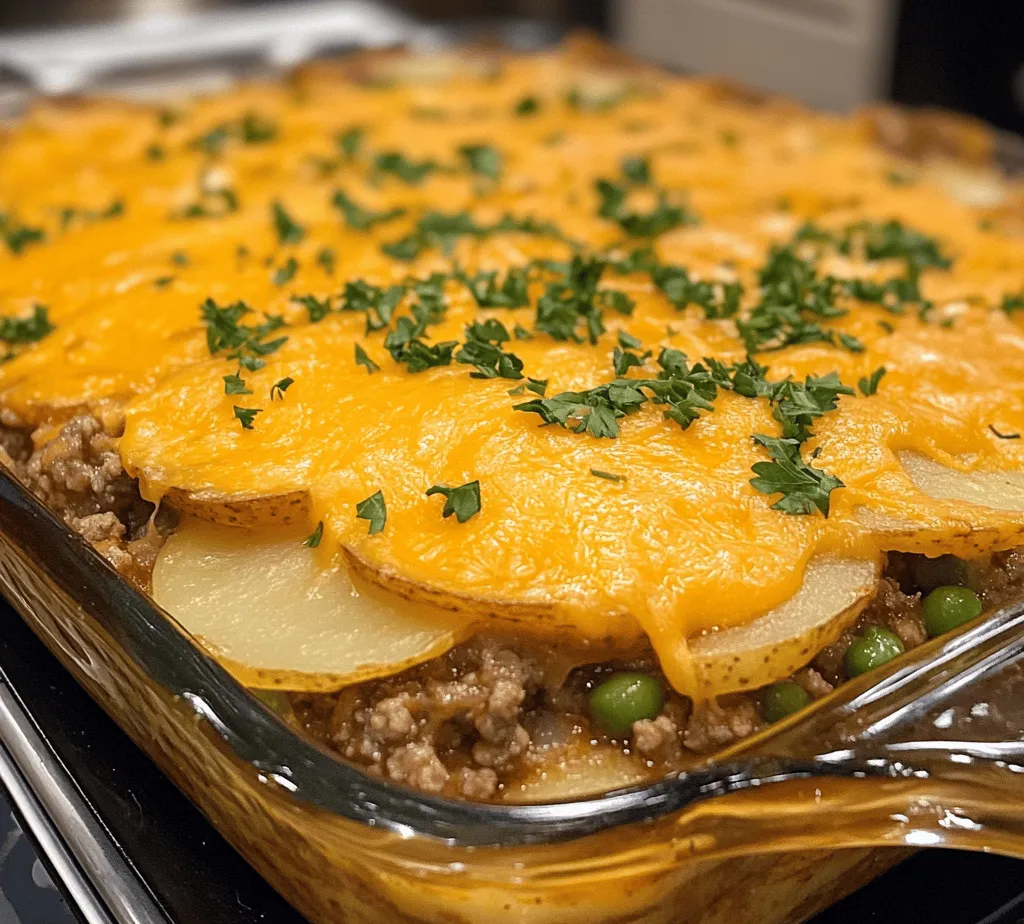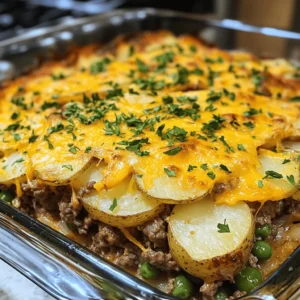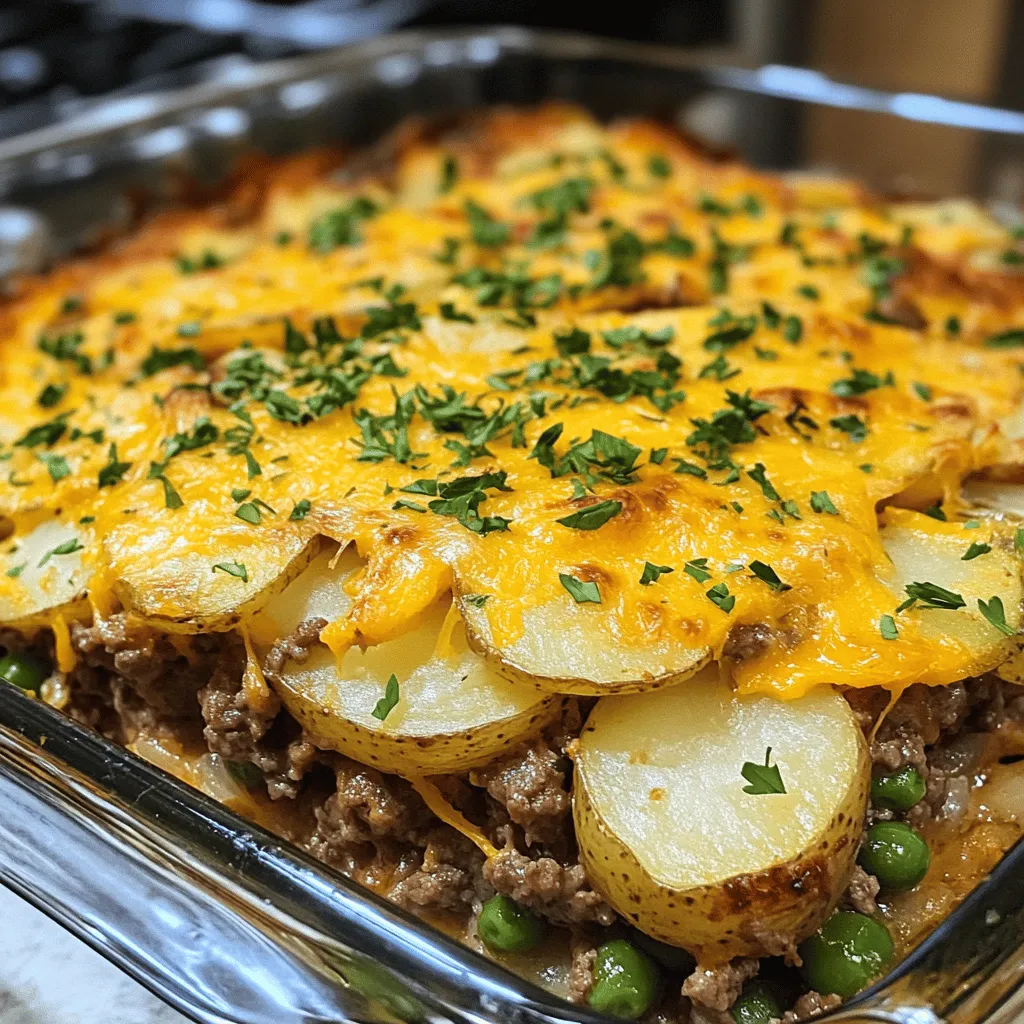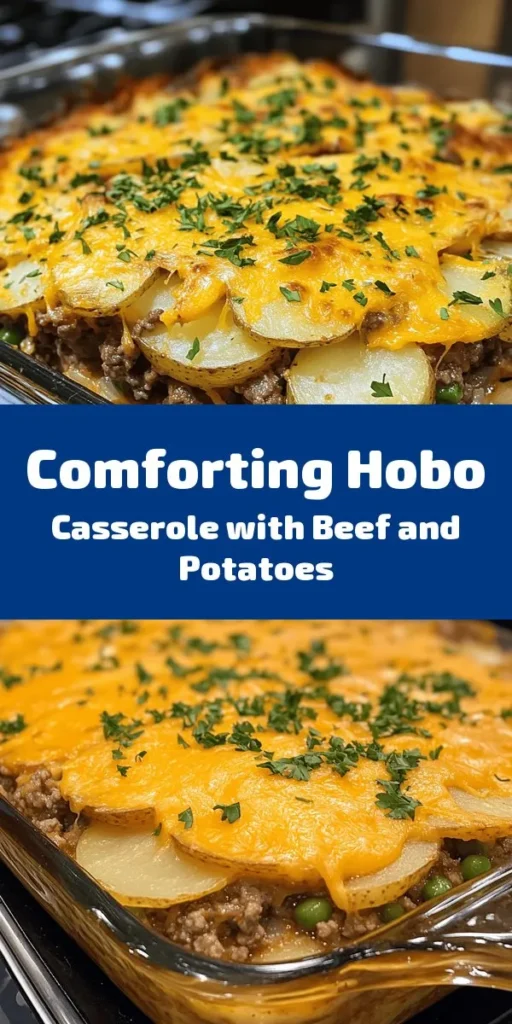Introduction
The term “Hobo Casserole” might evoke images of rustic campfire meals enjoyed by wanderers and travelers, but this dish has become a beloved staple in many households across America. At its core, a Hobo Casserole is a comforting, one-dish meal that combines hearty ingredients in a way that is both satisfying and convenient. It typically features ground beef, potatoes, and vegetables, all baked together to create a delicious and filling dish that is perfect for families.
The appeal of Hobo Casserole lies not only in its comforting qualities but also in its versatility. This dish can easily be adapted to accommodate various dietary needs, making it suitable for everyone at the dinner table. Whether you’re looking for a gluten-free option, a vegetarian version, or simply want to use up leftover ingredients, the Hobo Casserole can be tailored to fit your preferences. It’s this adaptability, combined with its hearty flavors, that makes Hobo Casserole a go-to recipe for busy weeknights and cozy family gatherings alike.
Understanding the Ingredients
The Role of Ground Beef
Ground beef serves as the primary protein source in this Hearty Hobo Casserole, providing both flavor and texture. It’s a key ingredient that brings the dish together, making it more filling and satisfying. When selecting ground beef, quality is paramount. Look for meat that is bright red in color with a little marbling, as this indicates tenderness and flavor. Ground beef typically comes in various fat percentages, ranging from lean (90% lean, 10% fat) to regular (80% lean, 20% fat). For a casserole, a balance between flavor and health can be achieved with ground beef that is around 85% lean.
Nutritionally, ground beef is an excellent source of protein, iron, and several B vitamins, which are essential for energy production and overall health. However, it’s important to keep in mind that higher fat content can increase calorie intake, so choosing leaner cuts may be beneficial for those watching their diet.
The Importance of Potatoes
Potatoes are another essential component of Hobo Casserole, providing substance and heartiness to the dish. The type of potatoes you choose can significantly affect the flavor and texture of your casserole. Common varieties include russet, Yukon Gold, and red potatoes. Russet potatoes are fluffy and absorb flavors well, making them ideal for casseroles, while Yukon Golds offer a creamier texture with a buttery flavor. Red potatoes, with their waxy skin, hold their shape and add a lovely color to the dish.
Including potatoes in your diet has numerous health benefits. They are rich in essential vitamins and minerals, particularly vitamin C, potassium, and dietary fiber. Additionally, potatoes provide a good source of carbohydrates, which are vital for energy. When preparing your casserole, consider slicing the potatoes thinly for quicker cooking and a more even texture throughout the dish.
Fresh and Frozen Green Beans
Green beans play a crucial role in adding texture and flavor to your Hobo Casserole. They bring a slight crunch and a fresh taste that contrasts beautifully with the richness of the ground beef and the creaminess of the sauce. You can use either fresh or frozen green beans for this recipe; however, it’s worth noting the nutritional comparison. Fresh green beans offer a crisp texture and vibrant flavor, while frozen green beans are often picked at peak ripeness and flash-frozen, retaining their nutrients and flavor.
When using fresh green beans, trim the ends and cut them into bite-sized pieces before adding them to your casserole. If you opt for frozen green beans, there’s no need to thaw them beforehand; simply mix them in directly. Regardless of the choice you make, green beans are an excellent source of vitamins A, C, and K, as well as fiber, making them a healthful addition to this hearty dish.
Cream of Mushroom Soup: A Creamy Base
Cream of mushroom soup serves as the creamy base for this casserole, binding all the ingredients together while adding depth to the dish’s flavor profile. You have the option of using store-bought soup for convenience or making homemade cream of mushroom soup for a fresher taste. If you choose the latter, you can control the ingredients and avoid preservatives often found in canned varieties.
For those looking for healthier substitutes, consider using a low-fat or reduced-sodium cream of mushroom soup. Alternatively, you can create a homemade version using sautéed mushrooms, onions, garlic, and a blend of milk and broth for a lighter yet creamy base. Not only does this elevate the flavor, but it also allows you to incorporate more wholesome ingredients into your casserole.
The Essential Cheddar Cheese
No Hobo Casserole would be complete without a generous layer of cheese on top. Cheddar cheese is a popular choice, known for its rich flavor and excellent melting qualities. However, you can also experiment with different varieties of cheese to suit your taste preferences. Monterey Jack offers a mild flavor and creaminess, while pepper jack adds a spicy kick. For a stronger flavor, consider using aged cheddar or Gruyère.
Beyond enhancing the flavor, cheese contributes nutritional benefits as well. It is a good source of protein, calcium, and other essential vitamins. When adding cheese to your casserole, consider mixing it into the dish and sprinkling an additional layer on top just before baking for a beautifully melted and golden finish.
Prepping Your Hearty Hobo Casserole
Preheating the Oven: Importance and Best Practices
Before diving into the assembly of your casserole, it’s essential to preheat your oven. Preheating ensures that your dish cooks evenly and thoroughly, allowing flavors to meld and develop. Set your oven to 350°F (175°C) and allow it to reach the desired temperature before placing the casserole inside. This step is crucial for achieving that perfect, bubbling, golden-brown top!
Cooking Ground Beef: Techniques for Perfect Browning
Next, it’s time to cook the ground beef. Start by heating a large skillet over medium-high heat. Once hot, add the ground beef, breaking it apart with a spatula as it cooks. To achieve perfect browning, avoid overcrowding the pan; if necessary, cook the beef in batches. Let it sit undisturbed for a couple of minutes before stirring to allow a nice sear to develop. Season the meat with salt, pepper, and any other spices you prefer, such as garlic powder, onion powder, or paprika, to enhance its flavor.
After the beef is browned and fully cooked, it’s important to drain any excess fat to prevent your casserole from becoming greasy. You can do this by carefully pouring the fat off or using a slotted spoon to remove the meat from the pan while allowing the fat to drain away.
Sautéing Vegetables: Enhancing Flavors
With the ground beef cooked and drained, it’s time to sauté the vegetables. Start by adding diced onions and minced garlic to the same skillet. The residual heat will help release their natural flavors and aromas. Sauté the onions until they become translucent and fragrant, about 3-4 minutes. Add in your green beans and continue to cook for another 2-3 minutes, just until they are slightly tender but still crisp. This step is vital, as it enhances the overall flavor of the casserole and ensures that the vegetables are perfectly cooked.
By following these initial steps, you lay a solid foundation for your Hearty Hobo Casserole with Ground Beef & Potatoes. The combination of quality ingredients, thoughtful preparation, and cooking techniques will lead to a dish that is both delicious and satisfying for your family.

How to Achieve the Right Texture for Vegetables
When creating a Hearty Hobo Casserole, the texture of your vegetables plays a pivotal role in achieving a delicious and satisfying dish. One of the key elements is ensuring that the vegetables are cooked just right—tender, yet still slightly firm to the bite.
Combining and Layering Ingredients
Mixing Ingredients: Achieving a Uniform Flavor
Once all your ingredients are prepped, the next step is to mix them together effectively. Start by placing your cooked ground beef in a large mixing bowl. Gradually add in the diced potatoes and vegetables, such as green beans and onions. Use a spatula or a large spoon to gently fold the ingredients together. This method ensures that the flavors meld beautifully without mashing the potatoes or breaking down the vegetables.
Importance of Evenly Coating the Potatoes and Beans with the Beef Mixture
Evenly coating the potatoes and beans with the beef mixture is crucial for flavor distribution. As the casserole bakes, the juices from the ground beef and any seasonings will infuse into the potatoes and vegetables, enhancing their taste. To achieve this, add your seasoning blend (salt, pepper, garlic powder, and onion powder) during the mixing process. This way, every bite will be seasoned to perfection.
Layering Techniques for Casserole Dishes
Casseroles often benefit from a proper layering technique, which can significantly enhance the overall texture and flavor. Start by placing half of the potato and beef mixture at the bottom of your greased casserole dish. This base layer will absorb any juices that drip down during baking, preventing the bottom from becoming soggy.
Next, layer the remaining mixture on top. This double-layering not only adds depth to the casserole but also allows for even cooking throughout. It’s important to avoid packing the ingredients too tightly; you want the heat to circulate properly.
Best Practices for Layering to Ensure Even Cooking
For even cooking, ensure that the layers are spread out evenly across the dish. Avoid creating large clumps of ingredients; instead, gently spread them with a spatula. This practice guarantees that every piece of potato and vegetable is exposed to the heat of the oven, allowing them to cook uniformly.
Visual Appeal: Arranging Ingredients for an Appetizing Presentation
Presentation matters when it comes to casseroles. To enhance the visual appeal, consider arranging the top layer of potatoes slightly overlapping. This not only creates a beautiful rustic look but also adds texture. For added color, sprinkle a small handful of shredded cheese on top before baking. This will melt into the dish and create a golden crust, enhancing the overall look.
Baking the Casserole to Perfection
The baking process is where all the magic happens, transforming the raw ingredients into a comforting, hearty meal.
Baking Tips: Covering vs. Uncovering
When baking your casserole, consider covering it for the first half of the cooking time. Covering the dish with aluminum foil traps steam, which helps cook the potatoes thoroughly and prevents them from drying out. After about 30-40 minutes, remove the foil to allow the top to brown nicely.
Why the Initial Cover is Important for Cooking
The initial cover is essential for creating a moist environment. It allows the potatoes to become tender while preventing over-browning. This method also helps in cooking the vegetables evenly, ensuring they don’t end up undercooked while the top layer gets too crispy.
Timing Adjustments Based on Oven Variations
Every oven is different; thus, keeping a close eye on your casserole is critical. Expect to bake it for approximately 60 to 75 minutes at 350°F (175°C). If you notice that the top is browning too quickly, reduce the temperature slightly and cover it loosely with foil to finish cooking without burning.
The Golden Cheese Top: Achieving the Perfect Melt
To achieve the perfect golden cheese top, add your cheese during the last 15-20 minutes of baking. This allows it to melt thoroughly and develop a bubbly texture. For a gourmet twist, consider mixing different cheese varieties, such as cheddar and mozzarella, for a richer flavor profile.
Serving Suggestions and Pairing Ideas
Once your Hearty Hobo Casserole is out of the oven and cooling slightly, it’s time to serve! Let the dish rest for about 5-10 minutes to allow the flavors to settle.
Ideal Serving Temperature and Presentation
Serve your casserole warm, directly from the oven. A large spoon or spatula will help you scoop out generous portions. For a beautiful presentation, consider plating the casserole on individual plates or in bowls. Garnish with fresh chopped parsley or chives to add a pop of color and freshness.
Suggested Side Dishes to Complement the Casserole
While the Hearty Hobo Casserole is a meal on its own, pairing it with complementary side dishes can elevate your dining experience. Consider serving a simple green salad with a light vinaigrette to balance the richness of the casserole. Additionally, crusty bread or garlic bread can make for a hearty addition, perfect for soaking up any delicious juices.
Salads, Bread, or Other Sides that Balance the Meal
A refreshing cucumber and tomato salad can provide a crisp contrast to the warm, comforting casserole. Alternatively, roasted or steamed vegetables can round out the meal without overpowering the main dish.
Creative Garnishing Ideas
For an appealing finish, sprinkle a handful of crispy fried onions on top before serving. This not only adds texture but also an extra layer of flavor. You can also try a drizzle of balsamic reduction or a dollop of sour cream for a tangy touch.
Nutritional Breakdown of Hearty Hobo Casserole
Understanding the nutritional content of your Hearty Hobo Casserole can help you appreciate its health benefits while planning meals.
Overview of Caloric Content and Macronutrients Per Serving
A standard serving of Hearty Hobo Casserole contains approximately 400-500 calories, depending on the amount of cheese used and the size of the serving. Each serving typically includes about 25 grams of protein, 20 grams of carbohydrates, and 25 grams of fat, making it a hearty option for a filling meal.
Health Benefits of the Ingredients Used
The combination of ground beef and potatoes provides a rich source of protein and carbohydrates, making this casserole a great option for an energy-boosting dinner. Additionally, the inclusion of green beans adds fiber and essential vitamins, promoting overall health.
Potential Modifications for Dietary Restrictions
For those with dietary restrictions, this casserole can easily be adapted. To make it gluten-free, ensure that you use gluten-free seasonings and sauces. For a vegetarian version, substitute the ground beef with lentils or a plant-based meat alternative, and use vegetable broth instead of beef broth.
Conclusion
The Hearty Hobo Casserole is more than just a meal; it embodies comfort and warmth, making it ideal for family gatherings or cozy weeknight dinners. The blend of flavors, textures, and the ease of preparation contribute to its appeal, inviting you to make this dish your own.
As you try out this recipe, feel free to experiment with different ingredients and seasonings to suit your family’s tastes. This casserole is flexible, allowing you to personalize it while still delivering a satisfying dining experience. Enjoy the process of making this hearty dish and relishing the smiles it brings to the table.



